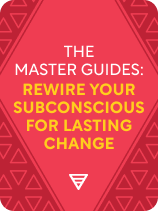

This article is an excerpt from the Shortform book guide to "The Master Guides: Rewire Your Subconscious for Lasting Change" by Shortform. Shortform has the world's best summaries and analyses of books you should be reading.
Like this article? Sign up for a free trial here.
Do you struggle to stop doing things you shouldn’t? Why is it hard to change unhealthy habits?
Your subconscious mind creates and relies on automatic routines, which has its advantages. But, this reliance has a negative flip side: It makes it difficult for you to break free from unhealthy habits.
Read more to learn from Charles Duhigg, Tony Robbins, and others why it’s hard to break out of negative routines.
Why It’s Hard to Change Unhealthy Habits
Why is it hard to change unhealthy habits? While automatic associations and routines (we’ll refer to both as “routines”) offer many benefits, such as keeping you safe and saving your mental energy, Charles Duhigg (The Power of Habit) points out a significant drawback: Your brain permanently stores these routines.
Holistic psychologist Nicole LePera (How to Do the Work) adds that, once your subconscious mind creates and permanently stores a routine, it categorizes it as a part of your internal makeup—when your subconscious mind must make a decision, it uses the routine like an instruction manual instead of appealing to your conscious mind.
Maxwell Maltz (Psycho-Cybernetics) points out the problem with this setup: Your conscious goals often differ from your internal programming. In other words, you may decide to adopt a new habit, but, deep down, your subconscious mind may not be programmed to sustain that habit because it has stored conflicting routines. This conflict between your conscious goal and your internal programming traps you in a loop of attempting new habits and reverting to old ones.
For example, your conscious goal is to adopt healthy eating as a habit. However, because you’ve been eating unhealthily for years, your subconscious mind has recorded conflicting routines that compel you to crave junk food or overeat.
Why Conscious Goals Conflict With Internal Programming
Why does this incongruence between your conscious goals and your internal programming occur? Self-help guru Tony Robbins (Awaken the Giant Within) suggests that, at some point, your subconscious mind associated your conscious goals with pain. For example, previous attempts to adopt healthy eating as a habit left you feeling deprived. Your subconscious mind categorized this feeling as painful and something you should avoid. On the other hand, each time you indulged in junk food, you felt satisfied. Your subconscious mind categorized this feeling as pleasurable and something you should move toward.
How Your Subconscious Mind Steers You Away From Pain
LePera argues that, since your subconscious mind believes that your automatic routines keep you safe (away from pain), it resists any attempts to change them. This resistance takes the form of mental and physical discomfort that you experience each time you attempt to deviate from your default patterns. For instance, you might experience anxious or negative thoughts, uncomfortable cravings, tension headaches, or stomach cramps. Your subconscious mind creates this discomfort to convince you to revert to your automatic routines—even if those routines cause you emotional or physical harm, the subconscious mind considers them “safe.”
For example, you want to adopt healthier eating habits because you know that over-indulging in junk food is bad for you. However, because your subconscious mind associates eating healthy with feeling deprived (unsafe, painful), it sabotages your efforts by heightening your cravings for junk food.

———End of Preview———
Like what you just read? Read the rest of the world's best book summary and analysis of Shortform's "The Master Guides: Rewire Your Subconscious for Lasting Change" at Shortform.
Here's what you'll find in our full The Master Guides: Rewire Your Subconscious for Lasting Change summary:
- Why the only way to change a bad habit is to rewire your subconscious
- Methods from experts such as Tony Robbins, Charles Duhigg, and Nicole LePera
- Why it's so important to take time for physical relaxation






